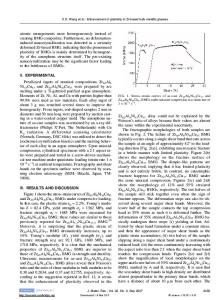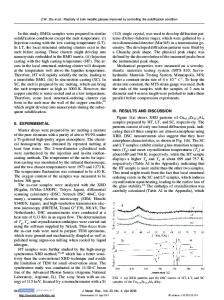The influence of in situ formed precipitates on the plasticity of Fe-Nb-B-Cu bulk metallic glasses
- PDF / 466,290 Bytes
- 7 Pages / 584.957 x 782.986 pts Page_size
- 3 Downloads / 249 Views
ng Kima) Department of Metallurgical Engineering, Center for Non-Crystalline Materials, Yonsei University, Seoul 120-749, Republic of Korea
Mihai Stoica and Norbert Mattern Institute for Complex Materials, Leibniz Institute for Solid State and Materials Research Dresden, D-01171 Dresden, Germany
Ran Li Department of Materials Science and Engineering, Beihang University, 100191 Beijing, China
Jürgen Eckertb) Institute for Complex Materials, Leibniz Institute for Solid State and Materials Research Dresden, D-01171 Dresden, Germany; and Institute of Materials Science, Dresden University of Technology, D-01062 Dresden, Germany (Received 7 April 2011; accepted 1 June 2011)
Improved room temperature plasticity was achieved by microalloying Cu in a series of (Fe71Nb6B23)100 xCux (x 5 0, 0.25, 0.5, 0.75, and 1) glass matrix alloys with tunable size and volume fraction of precipitates composed of a-Fe and Fe23B6 phases. When ;10-nm-sized nano-scale precipitates are formed with a size comparable to the shear bandwidth by controlling the added content of Cu, the (Fe71Nb6B23)99.5Cu0.5 alloy exhibits a maximum plastic strain of 4.3 6 0.8% with pronounced multiple shear banding. A further increase in the size of the precipitates up to micrometer scale results in catastrophic fracture accompanied with irregular cracks, revealing that the fracture mechanism of the different alloys is controlled by the precipitate size. I. INTRODUCTION
Address all correspondence to this author. e-mail: [email protected] b) This author was an editor of this journal during the review and decision stage. For the JMR policy on review and publication of manuscripts authored by editors, please refer to http://www.mrs. org/jmr-editor-manuscripts/ DOI: 10.1557/jmr.2011.202
localized deformation accompanied by strain softening and unstable shear banding events are the biggest obstacles for potential applications as advanced structural materials for BMGs.3,4 Therefore, the challenge of how to stabilize and manipulate the inhomogeneous plastic flow is one of the important issues to overcome the room temperature brittleness of BMGs. Second phases have been widely used in traditional crystalline alloys to optimize mechanical properties with a balance of strength, ductility, hardness, and fatigue resistance.5 The influence of second phases with difference size scale from the nanometer to the micrometer range on the mechanical properties has been discussed intensively.6 Normally, the introduction of second phases will tradeoff ductility for strength in crystalline alloys and alloy property optimization can be achieved through controlling the grain size and the morphology of the second phase particles/precipitates as well as by attempting to optimize dislocation-based deformation mechanisms and dislocation network structures.5,6 On the other hand, the influences of brittle or ductile micrometer-scale second phases (i.e., ex situ SiC and Ta particles and in situ Zr solid solution and CuZr intermetallic phases with
2080
Ó Materials Research Society 2011
Bulk m
Data Loading...











